My new visit to the minor basilica of Santa Inés, a prominent heritage site of Cumaná and the state of Sucre (Eng - Esp)

Hello fellow travelers, it's a pleasure to greet you and wish you a blessed and excellent day with your loved ones. There are only a few hours left until the end of October, and we'll be in the 11th month of the year, very close to the Christmas season. On this occasion, I'm sharing my recent visit to the Santa Inés Church, located on Sucre Street in Cumaná. This area is notable for housing various colonial-style buildings and institutions related to the state's culture and tourism, among them; The cultural center, the birthplace of Andrés Eloy Blanco, a very old school, the Santa María de la Cabeza castle, the birthplace of Antonio José de Sucre (a new construction that replicates the house where the Sucre hero was born), very close to the Ermita street, which leads to the San Antonio de la Eminencia castle, among others, the church constitutes one of the most important heritages of the state, due to its history and events that have been carried out there, including the baptism of the Cumaná hero Antonio José de Sucre, according to information from a guard of the church, it was built on the ruins of the old church of Our Lady of Carmen.
The church has an excellent corner location, offering a beautiful front and side view. It's light yellow, with a tower on each side, a central nave, and another nave at the altar. The towers house the bell towers and the oldest clock in town, which chimes every half hour, marking the passage of time. According to the caretaker, in years past, families used the clock's chimes to signal when to get up and start their daily activities. To the right of the church is a small plaza with walkways and several government offices. This area has concrete benches and various shrubs, ideal for chatting with friends in the afternoon. The church is surrounded by a perimeter fence with white railings decorated with rebar lanterns. This decoration is one of my favorites, as it reminds me of the stories I read in my childhood, where houses had these kinds of lamps hanging on the front and sides. Seeing them evokes a mix of feelings and emotions because so many memories come flooding back. I tend to associate these lamps with life in the village. where I played many times during my childhood and adolescence.
The temple possesses beautiful decorative elements such as cornices, a metal cross on both towers and in the central nave, on the front there are three arches that lead to the main entrance, the windows of the towers are semicircular, with stained glass of various colors, at night the colors green, blue and red can be seen, at the top, the towers have a gray dome, above them the aforementioned cross can be seen; after the perimeter fence of the church we find several steps known as "the steps of the Santa Inés church" where different cultural activities take place.
In another view, we observe in detail the three arches and the three doors that lead to the church. This photo is curious because a kind gentleman who was passing by the church asked me to take his picture because he wanted to be included in the publication. The gentleman happily posed for the camera. In this photo, we also appreciate a partial view of the Santa María de la Cabeza castle and some white posts with lantern-shaped lamps. Then we have a side view of the church and the altar dome. In the other, a rear view of the towers and the central nave. Next, the details of the towers, the cornices, grilles, and stained glass windows that adorn each window are preserved, as well as the columns that embellish the towers of this beautiful church. The white lamps located between the arches and the front doors can also be seen. Moving forward, there is a sign on one of the towers that identifies the church. My visit to this church was in the morning and small clouds could be seen in the clear sky. Something that I found curious is that the steps inside are rectangular and those beyond the perimeter fence are circular, creating a lovely spiral effect.
Hola amigos viajeros, es un placer saludarles deseando que tengan un bendecido y excelente día en unión de sus seres queridos, restan pocas horas para que finalice el mes de octubre y estaremos en el mes número 11 del año, muy cerca de la temporada navideña, en esta ocasión les comparto mi nueva visita a la iglesia Santa Inés, que se ubica en la calle Sucre de Cumaná, la cual destaca por albergar diversas construcciones del estilo colonial e instituciones relacionadas con la cultura y turismo del estado, entre ellas; el gabinete de cultura, la casa natal de Andrés Eloy Blanco, un colegio muy antiguo, el castillo Santa María de la Cabeza, la casa natal de Antonio José de Sucre (una construcción nueva que replica la casa donde nació el prócer sucrense), muy cerca de la calle la Ermita, que conduce al castillo San Antonio de la Eminencia, entre otros, la iglesia constituye uno de los patrimonios más importantes del estado, debido a su historia y eventos que allí se han se han realizado, entre ellos el bautismo del prócer cumanés Antonio José de Sucre, según información de un guarda de la iglesia, esta se construyó sobre las ruinas de la antigua iglesia nuestra señora del Carmen.
La iglesia tiene una excelente ubicación en esquina, ofreciendo una hermosa vista frontal y lateral. Es de color amarillo claro, con una torre a cada lado, una nave central y otra nave en el altar. Las torres albergan los campanarios y el reloj más antiguo del pueblo, que da las campanadas cada media hora, marcando el paso del tiempo. Según el encargado, antiguamente, las familias usaban las campanadas del reloj para saber cuándo levantarse y comenzar sus actividades diarias, a la derecha de la iglesia hay una pequeña plaza con senderos y varias oficinas gubernamentales, esta zona cuenta con bancos de cemento y diversos arbustos, ideal para charlar con amigos por la tarde, la iglesia está rodeada por una cerca perimetral con barandillas blancas decoradas con faroles de varilla de acero. Esta decoración es una de mis favoritas, ya que me recuerda a los cuentos que leía de niña, donde las casas tenían este tipo de lámparas colgando en las fachadas y los laterales. Verlas evoca una mezcla de sentimientos y emociones, porque me inundan los recuerdos, suelo asociar estas lámparas con la vida en el pueblo. donde jugué muchas veces durante mi infancia y adolescencia.
El templo posee hermosos elementos decorativos como; cornisas, una cruz de metal en ambas torres y en la nave central, en la parte frontal tiene tres arcos que conducen a la entrada principal, las ventanas de la de las torres son semicirculares, con vidrios de variados colores, en la nochese aprecian los colores; verde, azul y rojo, en la parte superior, las torres tienen una cúpula de color gris, encima de ellas se oberva la cruz mencionada; luego de la cerca perimetral de la iglesia encontramos varios escalones conocidos como "los escalones de la iglesia Santa Inés" en el cuales se realizan diferentes actividades culturales.
En otra vista observamos en detalle los tres arcos y las tres puertas que conducen a la iglesia, esta foto es curiosa porque un amable señor que pasaba por la iglesia me pidió que le tomara una fotografía pues él quería salir en la publicación, el señor muy feliz posó para la cámara, en esta foto apreciamos también una vista parcial del castillo Santa María de la Cabeza y unos postes de color blanco con las lámparas en forma de farol, luego tenemos una vista lateral de la iglesia y la cúpula del altar, en la otra una visión posterior de las torres y la nave central, acontinuación se onservan los detalles de las torres, las cornisas, rejas y vitrales que adornan cada ventana, además las columnas que embellecen las torres de esta hermosa iglesia, también se aprecian las lámparas de color blanco ubicadas entre los arcos y las puertas frontales, avanzando hay un cartel en una de las torres que identifica la iglesia; mi visita a esta iglesia fue en horas de la mañana y se aprecian pequeñas nubes en el cielo despejado, algo que me pareció curioso es que los escalones en la parte interior son de forma rectangular y los que están después de la cerca perimetral son circulares, creando un lindo efecto de espiral.








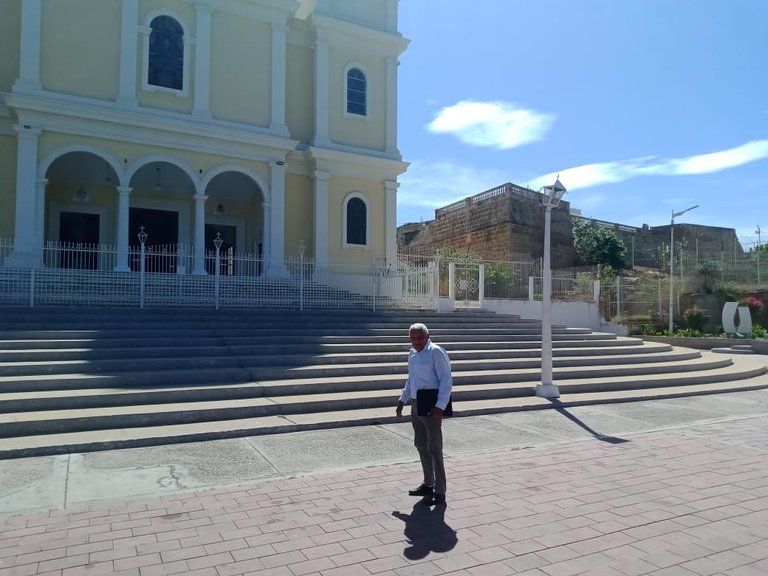





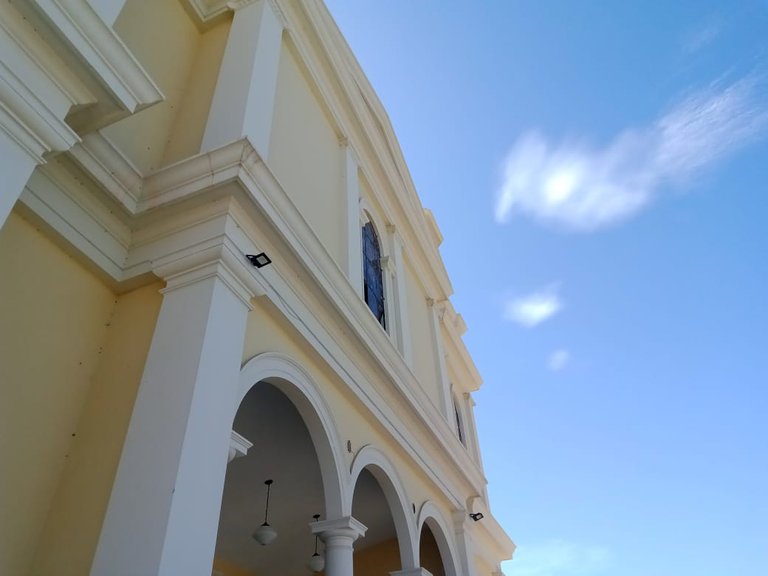





On the central front section, several plaques describe the various significant events that have taken place in the church, the date of its construction, the baptismal certificate of Antonio José de Sucre, the renovations carried out in 1929, 1957, and 1972, and its elevation to a minor basilica in 2024. The church has a beautiful design; the front features towers and a central nave, as well as three arched entrances followed by doors, the central one being larger than the side doors.
Above the side doors are two coats of arms. They are completely different, and I don't know their meaning. The first is yellow, red, blue, and white; the second is only yellow, white, and red and appears to depict several ears of wheat, a ribbon at the top, and a red cord. These are visible above the cornice that adorns the side doors.
En la parte central frontal, se encuentran varias placas que describen los diversos eventos de envergadura que se han llevado a cabo en la iglesia, la fecha de su construcción, la fe de bautismo de Antonio José de Sucre la remodelaciones que se han hecho en años 1929, 1957 y 1972, también su elevación a basílica menor en el año 2024, la iglesia tiene un hermoso diseño en la parte frontal se observan las torres y la nave central, también las tres entradas en forma de arco seguidas de las puertas, una central, más grande que las laterales.
En la parte superior de las puertas laterales se encuentran dos escudos, son totalmente diferentes y desconozco el significado de ellos, el primero es de color amarillo, rojo, azul y blanco, el siguiente solo tiene los colores amarillo, blanco y rojo y parece representar varias espigas, un lazo en la parte superior y un cordón de color rojo, estos se aprecian encima de la cornisa que adorna las puertas laterales.




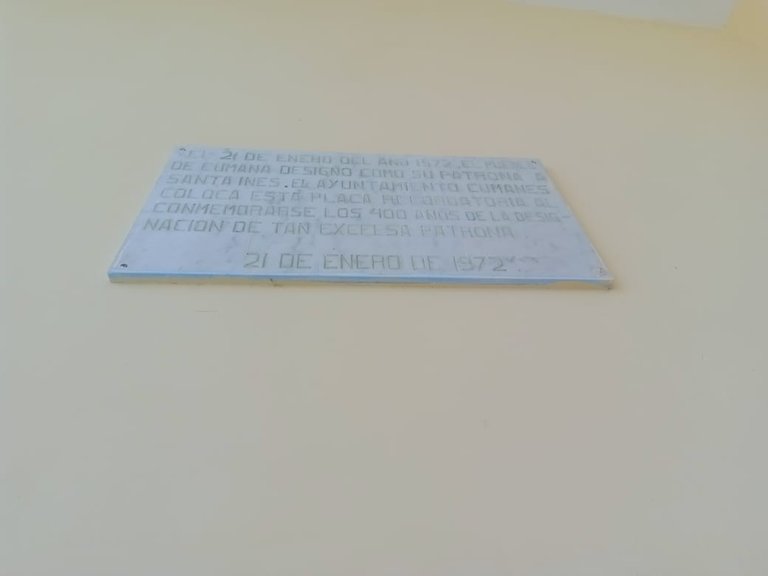

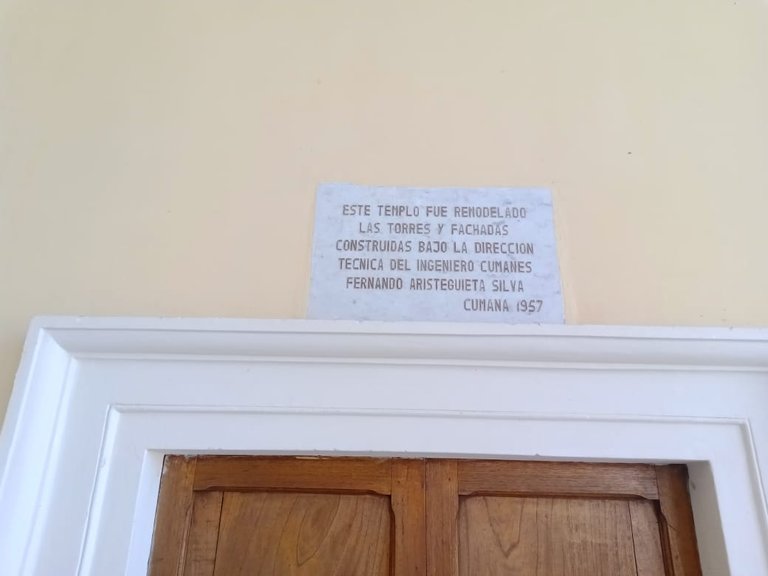
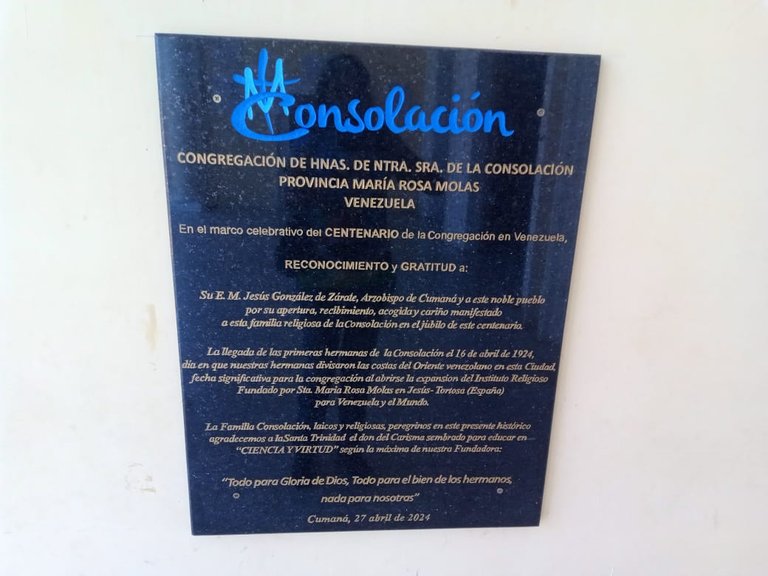


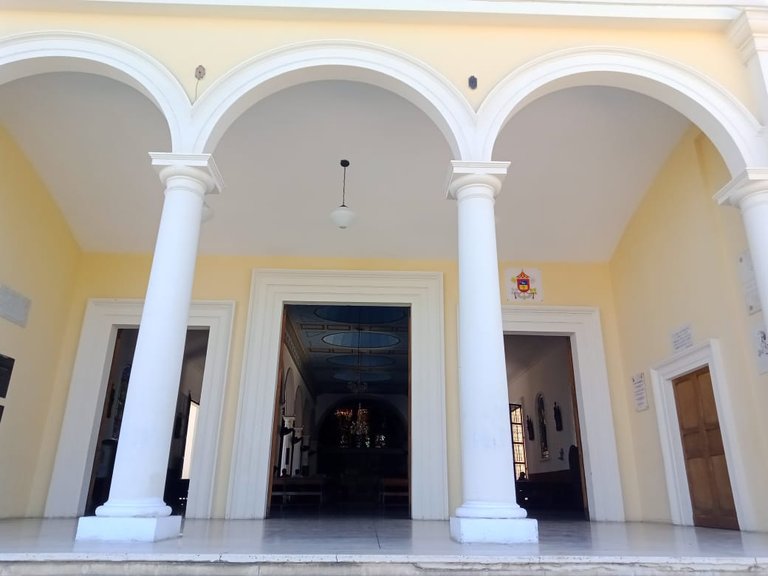


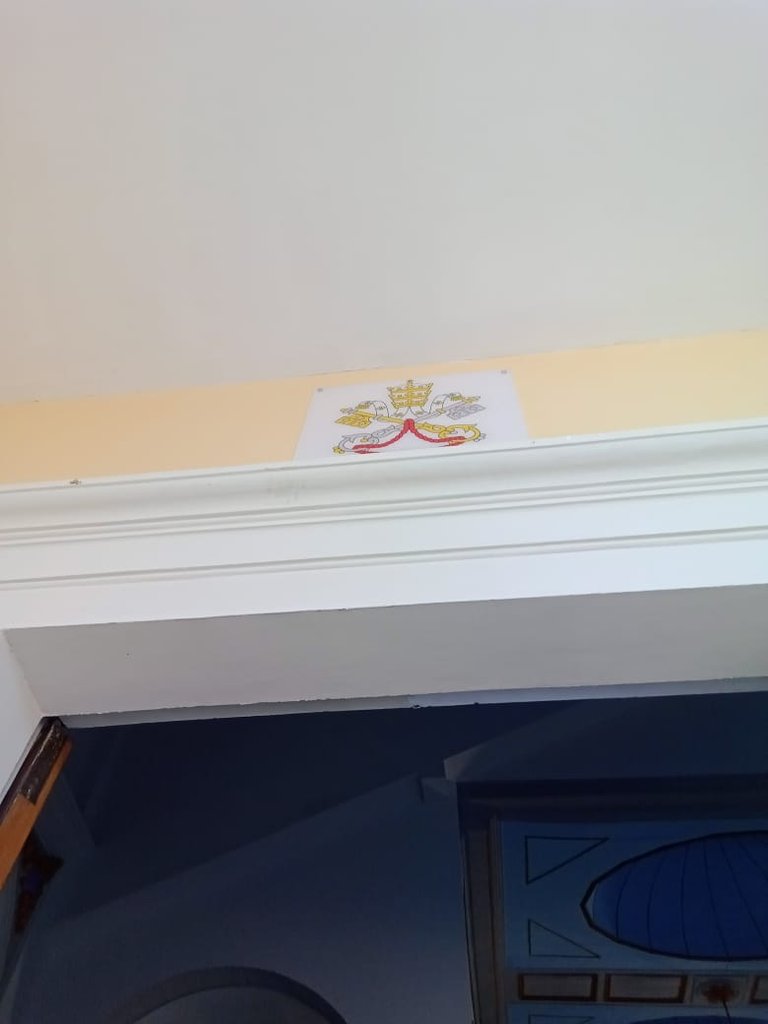

After taking a short walk around the exterior of the church, I headed towards the side door to enter. In the photo, you can see the decorations on the gate, with lanterns topped with a cross. You can also see the church windows, which have a design similar to those in the towers. The interior design is very beautiful, highlighted by its white columns and arches, altars or niches located along the sides, adorned with flowers and colorful stained-glass windows that create a lovely effect when the sunlight shines through. The granite floor is decorated with flowers and ribbons that separate the side aisles from the central one, where the pews are located. To the sides of the pews are other narrower aisles that lead to small niches. At the end of the central aisle is the altar with a beautiful painted decoration on the wall and a large dome decorated with blue dots. The church is open to the public in the mornings, every day. Once inside, you can access through the next side door to the Santa María de la Cabeza castle.
Luego de hacer un pequeño recorrido por la parte exterior de la iglesia, me dirigí hacia la puerta lateral para ingresar, en la foto se pueden observar las decoraciones en la reja, con faroles los cuales tienen una cruz en la parte superior, también vemos las ventanas de la iglesia que tienen el diseño similar a las ubicada en las torres, el diseño interior es muy bonito resalta por sus columnas y arcos de color blanco, altares o cubículos ubicados a los lados, acompañados con flores y coloridos vitrales, que crean un lindo efecto al ser atravesado por los rayos del sol, el piso es de granito con decoraciones de flores y cintas que separan los pasillos laterales del central, en ellos se ubican los bancos, a los lados de los bancos hay otros pasillos más angostos que conducen a pequeños cubículos, en el pasillo del centro, al final se encuentra el altar con una hermosa decoración de pintura en la pared y una gran cúpula decorada con puntos de color azul, la iglesia está abierta al público en horas de la mañana, todos los días, especialmente en horas de la mañana, ya en el interior, puedes acceder por la siguiente puerta lateral al castillo Santa María de la Cabeza.













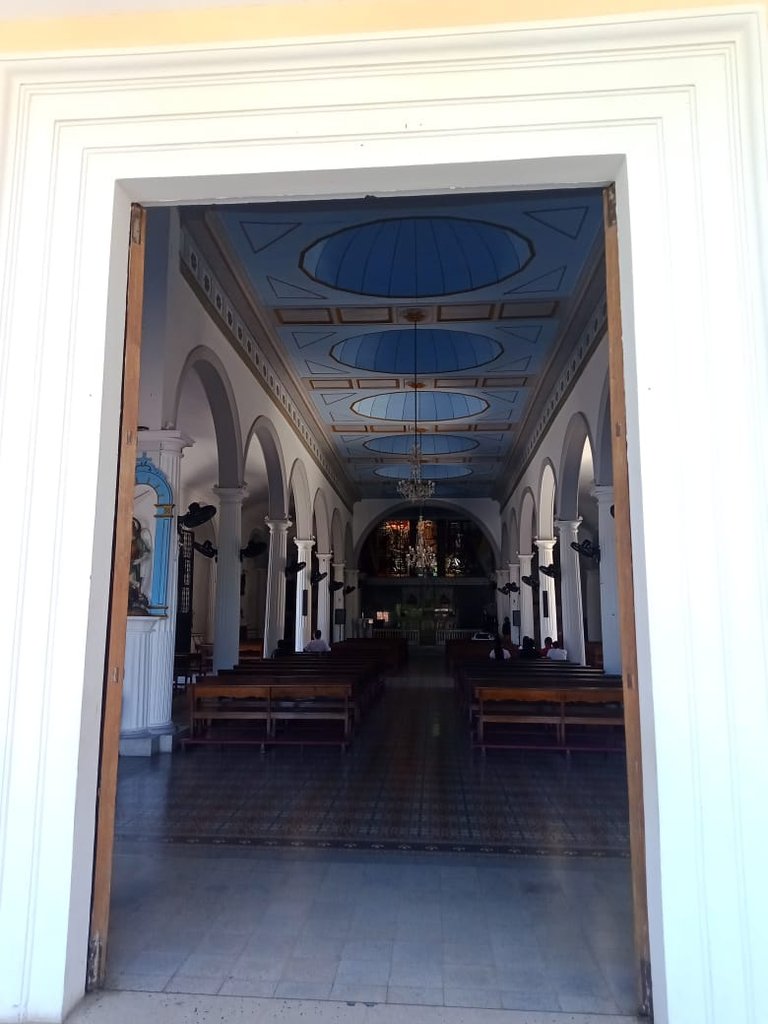



The doors are rectangular and made of wood. During the commemoration of the city's birthday on November 27th, the church serves as a stage for various cultural and musical activities, as well as theatrical performances depicting life during the colonial era. Children from educational institutions regularly participate in diverse cultural activities during this celebration. In December, colorful lights decorate the church, which constitutes a cultural landmark and heritage site for the city and the state.
In a complete view of the interior design, we appreciate the four aisles with their respective pews, the altar at the end, the floor decoration, and we see the side arches where there are several stained-glass windows. We also see a view from inside the church towards the front, where we see the leaves of the central door, decorated with paintings and wooden strips, and the two side doors. There is also a mezzanine where there are several sculptures of saints and a beautiful white lamp hanging from the ceiling. Next, we again see the pews and a wooden strip decorating the wall, followed by another beautiful stained-glass window, and another panoramic view of the church interior, in which we appreciate the design and decoration of the ceiling, which consists of blue dome-like shapes separated by a line formed by light brown rectangles. Moving forward, we see other stained-glass windows, a corridor with its respective altar, and another corridor with several altars. Here, we observe the decorations on the floor, which are indeed very beautiful. Visiting this church again was a lovely experience, and I had the opportunity to take a complete tour of each of its spaces. I also met a guard who explained to me part of the history of this important church, which constitutes a prominent heritage site in the city. I was also able to appreciate the colonial architecture present in the city with its beautiful decorations such as cornices, details in the windows, columns, among other elements typical of this style.
Las puertas son rectangulares y de madera durante la conmemoración del cumpleaños de la ciudad que es el 27 de noviembre, la iglesia sirve de escenario para el desarrollo de diferentes actividades culturales, musicales y representaciones y teatros de la vida durante la época colonial, en esta celebración regularmente los niños de las instituciones educativas, participan variadas actividades culturales, en el mes de diciembre las coloridas luces decoran la iglesia, la cual constituye un punto de referencia cultural y un patrimonio para la ciudad y el estado.
En una vista completa del diseño interior apreciamos los cuatro pasillos con sus respectivos bancos, el altar al final, la decoración del piso y vemos los arcos laterales donde se encuentran varios vitrales, también una vista desde el interior de la iglesia hacia la parte frontal, en ella vemos las hojas de la puerta central, decorada con cuadros y listones de madera y las dos puertas laterales, también una mesanina donde se encuentran varias esculturas de santos y una hermosa lámpara de color blanco que cuelga del techo, a continuación nuevamente apreciamos los bancos y un listón de madera que decora la pared, seguidamente otro hermoso vitral, otra panorámica del interior de la iglesia, en la cual apreciamos el diseño y decoración del techo, son especies de cúpula en color azul separadas por una línea formada por rectángulos de color marrón claro, avanzando vemos otros vitrales un pasillo con su respectivo altar, otro pasillo con varios altares, en este se observan las decoraciones que tiene el piso, que por cierto son muy hermosas; visitar esta iglesia nuevamente fue una linda experiencia y tuve la oportunidad de hacer un recorrido completo por cada uno de sus espacios, pude coincidir también con un guarda quien me explicó parte de la historia de esta importante iglesia que constituye un patrimonio destacado en la ciudad, también pude apreciar la arquitectura colonial, presente en la ciudad con sus hermosas decoraciones como, cornisas, detalles en las ventanas, columnas, entre otros elementos propios de este estilo.
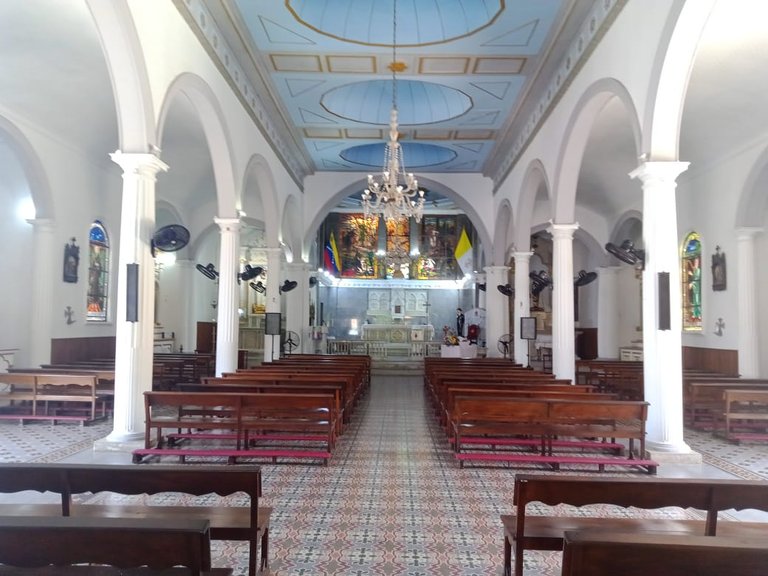











Blessings!

¡Bendiciones!

Translated with https://www.deepl.com/translator
All images are my own.
Todas las imágenes son de mi autoría.
You can check out this post and your own profile on the map. Be part of the Worldmappin Community and join our Discord Channel to get in touch with other travelers, ask questions or just be updated on our latest features.
Gracias @worldmappin
Saludos!
Con gusto amiga 🥰 gracias por seguir usando @worldmappin e incluir esta ubicación en el mapa 🤗
What a beautiful visit to Santa Inés! Your photos make me want to explore it too got any plans for your next trip? ✨
Hi @itzcyrene, the church is very beautiful. I think its corner location gives it visibility and elegance. Next time I'm going, I plan to visit the fortress next door.
Happy weekend!
Hiya, @lauramica here, just swinging by to let you know that this post made it into our Top 3 in Travel Digest #2729.
Your post has been manually curated by the @worldmappin team. If you like what we're doing, please drop by to check out all the rest of today's great posts and consider supporting other authors like yourself and us so we can keep the project going!
Become part of our travel community:
Hola @lauramica y @worldmappin, agradecida por el apoyo.
Feliz fin de semana!
Está bien merecido, siempre es un gusto leerte 👌 sigue así 😀
Congratulations @belkyscabrera! You have completed the following achievement on the Hive blockchain And have been rewarded with New badge(s)
Your next target is to reach 310000 upvotes.
You can view your badges on your board and compare yourself to others in the Ranking
If you no longer want to receive notifications, reply to this comment with the word
STOPCheck out our last posts:
Muchas gracias @hivebuzz
Feliz fin de semana!
¡Es perfecto @belkyscabrera! ¡Tienes lo que se necesita para lograr este nuevo objetivo en Hive! ¡Sigue así!
Me fascinan los detalles arquitectónicos de este templo tanto en su interior como en su fachada externa, la historia que guardan sus paredes es de gran valor cultural y religioso para Cumaná, toda una joya llena del patrimonio de la región.
Saludos @noalys, la iglesia tiene lindos detalles arquitectónicos y forma parte importante de la historia de la ciudad, en ella fue bautizado el prócer cumanés Antonio José de Sucre, un importante personaje de la región y el país, aunque ha sido reparada varias veces mantiene gran parte del modelo original.
Feliz sábado!
Basilica is a beautiful state, your new travel energy is attractive, the interior of the building with the beautiful palace of this place and the designs around the huge circular building are charming. The wooden chairs in rows, although hard, are comfortable for a while. I wish you success in your trip, thank you friend.
Hi @mdakash62, it's true, the basilica has a beautiful architectural design and various decorative details both inside and out. The decorative details on the floor look great and complement the pews; every detail of its structure was very well thought out.
Cheers!
Such beautiful places are really interesting, thank you friend.
Muchas gracias por el apoyo @biologistbrito
Feliz fin de semana!
it seems, you have a nice visit to the Sacred place basilica santa inés.
Greetings @crstypatata, the church has a beautiful design; it was a pleasant and comprehensive tour of the entire structure.
Happy weekend!
Excelente. Gracias por compartir.
Saludos @joanm897, es una hermosa iglesia con un gran diseño.
Feliz sábado!